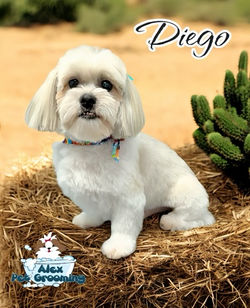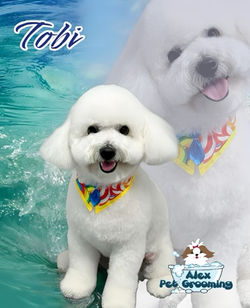




 |  |
|---|---|
 |  |
 |  |
 |  |
 |  |
 |  |
 |  |
 |  |
 |  |
 |  |
 |  |
 |  |
 |  |
 |  |
 |  |
COAT & SKIN CARE
Coat and skin care are vital to a healthy happy pet. If your pet has a short coat, feed them well with high quality dog food and bath in between grooming. In Florida it is important to monitor your pet for fleas and treat with a flea products if these pests are present. Treating will help prevent allergies pets tend to get from flea saliva.
If your dog has longer hair, brushing and bath in between grooming is highly recommended to help prevent hot spots and maintain skin health. In the long run a little brushing will save you tons at the vet.
SIGNS OF SKIN PROBLEMS- YOUR PET MAY NEED A VET
- Scratching, licking or chewing at skin
- Scabs
- Redness or inflammation
- Hot Spots (one particular area where itching is intense)
- Round, scaly patches on the face and paws
- Dry, flaky or otherwise irritated skin
- Hair loss, bald patches
- Rashes
- Lesions
- Drainage of blood or pus
- Swellings, lumps or skin discoloration
- Rubbing face against furniture or carpeting
NAIL CARE
As a rule of thumb, a dog’s nails should be trimmed when they touch the ground. For leisurely living dogs, that might mean weekly pedicures, while urban pooches who stalk rough city sidewalks might never need their nails cut at all. Don't forget to check the dew claws, if they have them. It is best to take off a tiny bit each week or every other week than to take chunks off less often. The quick in the nail tends to grow longer when trimming is not done routinely and this can cause problems for your pet.
A GREAT VIDEO FOR NAIL TRIMMING
ORAL CARE
Bacteria in an animal’s mouth can get into a pet’s bloodstream and infuse different organs, causing infections that can potentially cause death.
To prevent dental disease, your pet needs routine dental care at home. To perform good home care, you need to start with clean teeth. Brushing will remove plaque but not tartar. So if your pet's teeth have tartar, it is necessary for your veterinarian to remove it and polish the teeth. This professional veterinary dental cleaning is also called a prophylaxis or "prophy." A routine dental cleaning consists of:
-
Anesthetizing your pet and flushing the mouth with a solution to kill the bacteria.
-
Cleaning the teeth with handheld and ultrasonic scalers. All calculus is removed from above and below the gum line.
-
Using a disclosing solution to show any areas of remaining calculus which are then removed.
-
Polishing the teeth to remove microscopic scratches.
-
Inspecting each tooth and the gum around it for any signs of disease.
-
Flushing the mouth, again, with an antibacterial solution.
-
Recording any abnormalities or additional procedures on a dental chart. (Radiographs - x-rays - may be taken to evaluate the roots of the teeth and the bone.)
-
Determining the best follow-up and home dental care program for your pet.
HOW TO CLEAN PETS TEETH AT HOME
Try to make teeth brushing a daily affair. Consistency helps your pet except having their teeth cleaned easily.
Start by conditioning the pet to having his/ her gums touched by rubbing with your finger back and forth in a brushing motion. Once your pet accepts having their gums massaged, replace your finger with the brush and then add toothpaste. Be sure to get the paste and brush that is made special for your pet.
SIGNS YOUR PET NEEDS A VET -
-
Bad breath
-
Loose or discolored teeth or teeth covered in tartar
-
Your pet is not comfortable with you touching within the mouth area
-
Drooling or dropping food from the mouth
-
Bleeding from the mouth
-
Loss of appetite or loss of weight
EAR CARE
Your dog’s regular grooming/maintenance routine should include regular ear checks. This is especially important for dogs who produce excessive earwax or have a lot of inner-ear hair:
-
If your dog’s inner ears appear dirty, clean them with a cotton ball dampened with mineral oil, hydrogen peroxide or a solution formulated specifically for this purpose. Inner-ear skin is delicate, so allow your vet to demonstrate the proper method for cleaning your dog’s ears.
-
Do not clean your dog’s ears so frequently or deeply as to cause irritation, and take care to NEVER insert anything into your dog’s ear canal.
-
If your dog sprouts hair from his ear canal, you or your groomer may have to tweeze it out every few weeks to prevent problematic mats and tangles from forming. Please discuss with your vet whether this is necessary for your dog.
Here is a video how to clean your pets ears.
SIGNS YOUR PET NEEDS A VET
-
Ear discharge
-
Bad smells
-
Redness
-
Swelling
-
Crusty skin
-
Hair loss
Please also be aware that brown or black ear wax-and dry, dark wax resembling coffee grounds-are classic indicators of microscopic ear mites. Only your vet can tell for sure, so please don’t delay bringing a gooey-eared pooch in for a checkup.